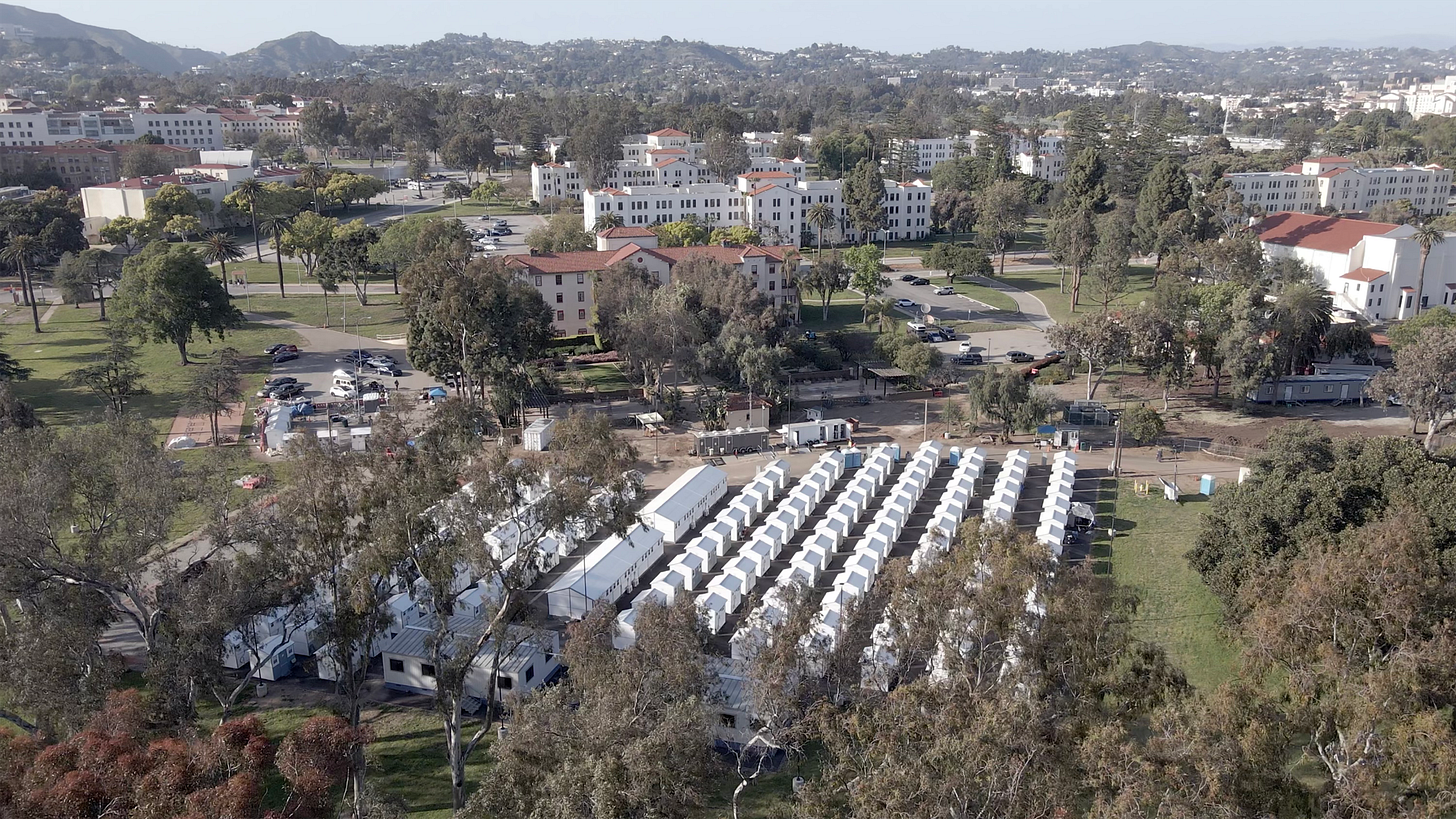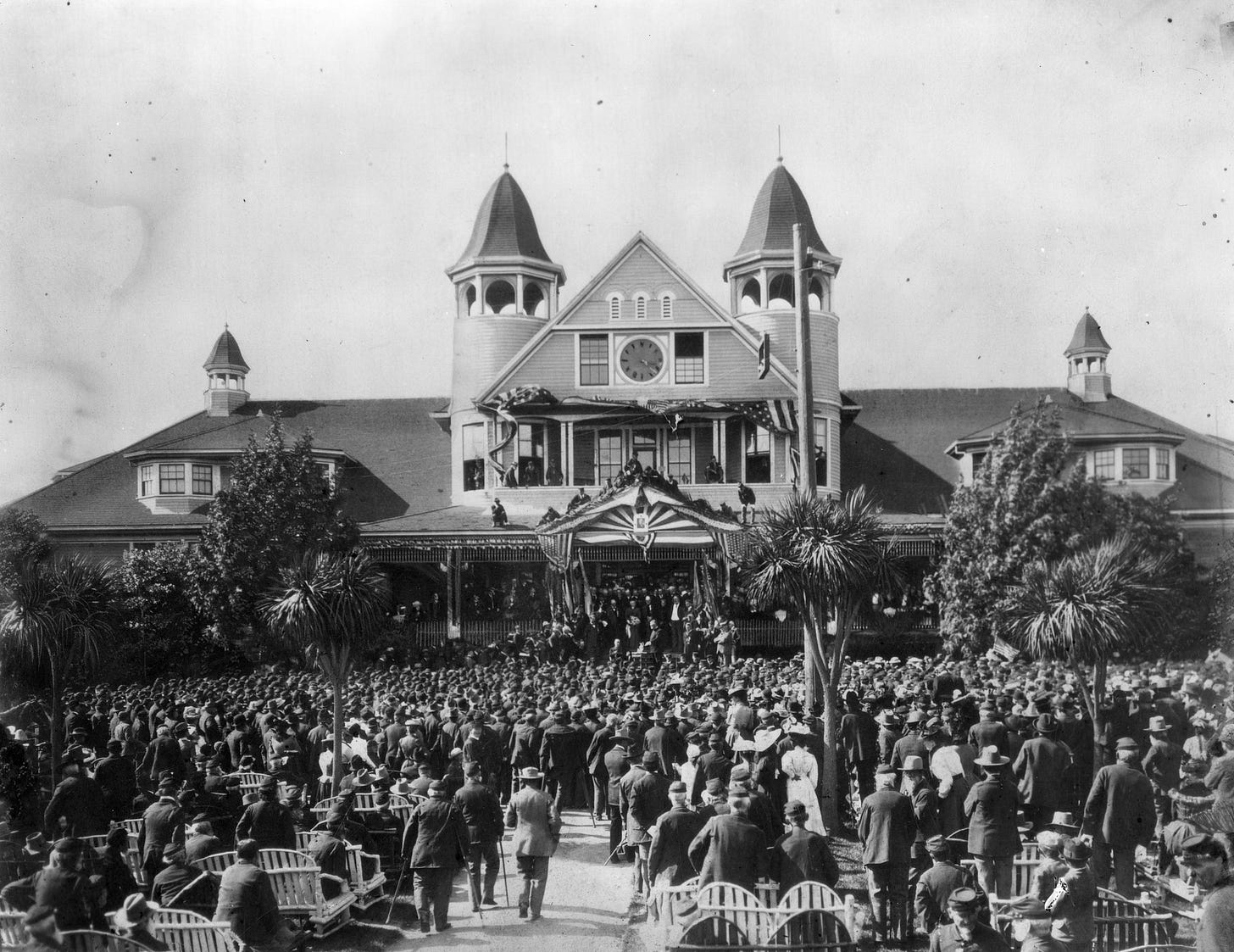White House orders housing for 6,000 homeless veterans be built on West LA VA campus
“We can definitely start housing veterans here — and across America,” says one recently-housed veteran upon hearing the news.

On Friday, May 9, 2025, President Donald Trump signed an executive order to establish a National Center for Warrior Independence in West LA “with facilities and resources to help our veterans earn back their self-sufficiency.” The goal of the center is to house 6,000 veterans on the property by 2028.
A statement by VA Secretary Doug Collins accompanying the order called out “decades of mismanagement” at the 388-acre campus, and pointed to land leases to the Brentwood School for an athletic facility and UCLA for a baseball stadium as examples of the property’s misuse by prior administrations.
“Today’s executive order will enable us to ensure VA’s West Los Angeles Campus is being used as intended: to benefit Veterans,” Collins’ statement reads. “Our goal is to turn the campus into a beacon of hope and a destination for homeless Veterans from across the nation who can travel there to find housing and support and start their journey back to self-sufficiency.”
Get the whole story: An epic government scandal hiding in plain sight
Home of the Brave is an award-winning, multimedia feature documenting the unhoused veteran crisis at the West LA VA campus, a 388-acre property deeded to the U.S. government in 1888 specifically to house disabled soldiers. Over the last 50 years, the land was carved up and leased to private interests, while development for veteran housing has been painfully slow. A land grab dating back to the U.S. Civil War, the history of this land is a story bursting with government malfeasance, neglect, graft, and even death.
Veterans and advocates are thrilled by the White House’s new position on the long troublesome VA campus. “That’s some really great news — it just amazes me that it took an executive order to do it,” says veteran Robert Rosebrock upon hearing the news at his home in Indianapolis. Rosebrock began protesting in front of the West LA VA in 2008 — and stood guard at its gate for 804 consecutive Sundays — to raise awareness of the property’s misuse.
“It's a really big win for all the veterans to have the White House actually acknowledge the fact that we need thousands of units of housing on this property, and also that the VA has entered into illegal land use agreements over the years,” says Rob Reynolds, a veteran and veterans advocate who has been working to solve the issue since he was turned away from the West LA VA when he arrived there for services in 2020.
A tear rolled down Air Force veteran Robert Canas’s cheek when Reynolds told him the news. Canas lives in one of the few apartments developed for unhoused veterans on the West LA VA campus. “We can definitely start housing veterans here — and across America,” Canas says. “Hopefully this will become part of the military vernacular, you know, like the old Soldiers Home.”
The Rise and Fall of the Soldiers Home

One month before Abraham Lincoln’s assassination in 1865, the president signed legislation establishing the National Asylum (later Home) for Disabled Volunteer Soldiers — a predecessor of today’s VA. In 1888, a trio of local industrialists donated hundreds of acres of undeveloped Los Angeles real estate to the U.S. government specifically to house disabled soldiers near the Pacific Ocean. In 1901, President William McKinley formally dedicated that branch of the Soldiers Home — now the West LA VA — with these words:
“The government for which you fought, to which you gave the best years of your lives — that government will see to it that in your declining years you shall not suffer, but shall be surrounded with all the comforts and all the blessings which a grateful nation can provide.”
What happened to that land and why did vets stop living on it? Learn more by reading Part Two of Home of the Brave.
Despite the news, details for this initiative are unclear. For instance, the executive order says “The VA campus in West Los Angeles will become the National Center for Warrior Independence,” and two paragraphs later says the VA will “designate a National Center for Warrior Independence on the West Los Angeles VA Campus.”
In addition, neither the order nor the VA Secretary’s statement addresses a federal judge’s September 2024 ruling invalidating the leases and October 2024 order to build housing. They also do not mention the Trump administration’s appeal of the case that was argued in U.S. Court of Appeals for the Ninth Circuit just 30 days ago. Mark Rosenbaum, lead counsel for the plaintiffs in the class action suit, had not seen the executive order in advance of it being released and declined to comment for this report.
Meanwhile, The Veterans Collective (TVC), a group of private developers who were given 99-year enhanced-use leases by the VA to build housing on the campus, applauds the plan. “We agree with the White House: our heroes deserve better,” the group says in a statement. “Our current plan will deliver a thriving Veteran community on the West LA VA campus, with at least 1,200 new units of housing, with critical support services, by the end of the President’s term.”
In a 2015 court settlement between the VA and veterans, the parties agreed 1,200 housing units would be opened by 2030, but the government has been chronically behind in developing units. To date, 497 permanent supportive housing units have opened as of May 1.
Carving up the map
After prohibiting veterans from living permanently on land donated to house them, the VA entangled itself in a wild array of leases on the valuable Los Angeles property — from soccer pitches to parrot sanctuaries — inhibiting the government from solving a homeless crisis of its own creation.
If the VA isn’t housing veterans on this land, what is the property being used for? Learn more by reading Part Four of Home of the Brave.
To address veteran homelessness, the executive order directs the Secretary of Housing and Urban Development to use vouchers to support homeless veterans in the LA metropolitan area and around the nation — a practice that’s already in use.
In last month’s appeals hearing, DOJ lawyer Daniel Winik, acknowledged the VA had used enhanced rental vouchers to make progress in LA’s veteran homeless crisis. Rosenbaum, meanwhile, called the VA rental voucher system “a tragedy.”
But it’s possible both parties are right — vouchers can be tragic but LA’s homeless numbers are down in the past year. “The Greater Los Angeles VA Health Care System staff and its local partners made record progress on reducing veteran homelessness between 2023 and 2024,” says Kathryn Monet, chief executive officer of the National Coalition for Homeless Veterans. But, she notes, LA is among the country's most challenging housing markets. That means there’s an inventory problem that only building more housing units can solve.
Watch: “The Promised Land”
In the National Magazine Award-nominated documentary short “The Promised Land,” Bronze Star Army veteran and documentary filmmaker Rebecca Murga provides an unflinching look at LA’s homeless veteran crisis, letting unhoused heroes provide a street-level view of what life is like when your government leaves you behind.
Learn more about these veterans, their lives, and their struggles, watch “The Promised Land” today.
Where the executive order could be impactful — and we’ll soon know if it is — is how it spurs development faster. The order requires that within 120 days, the president be given an action plan for housing up to 6,000 homeless veterans on the property by January 1, 2028. Yet, a development plan already exists: Master Plan 2022 is currently being executed against and has been negotiated and revised on an ongoing basis — including during Trump’s first administration — since the 2015 settlement of the Valentini v. Shinseki lawsuit.
The executive order proposes that funding to build more housing faster could come from “funds that may have been spent on housing or other services for illegal aliens.”
However it is financed, Monet hopes people come together to turn the idea into a reality. “As the Administration plans to deploy new resources, we encourage collaboration and the seeking of input from veterans experiencing homelessness in LA, and national and local stakeholders to learn from the past and build a brighter future,” she says.
And the veterans hope that this future will look something akin to the property’s past. “[The executive order] is such a major victory, all the way around,” says Rosebrock. “It gets [the campus] back to square one — to being permanently maintained as a National Home.”
Reynolds agrees. “I’m thankful that the president has acknowledged the situation at the West LA VA and has taken the position that this property was intended to be a Soldier's Home, as it was when it was donated over 100 years ago,” he says.
“I’m so very happy with this,” Reynolds adds, “and looking forward to getting to work in getting these housing units built and ending veteran homelessness once and for all.”
The Home of the Brave newsletter reports on how veterans are fighting to reclaim the land through Powers v. McDonough, a class-action lawsuit filed against the Department of Veterans Affairs. Get updates delivered to your inbox here:







